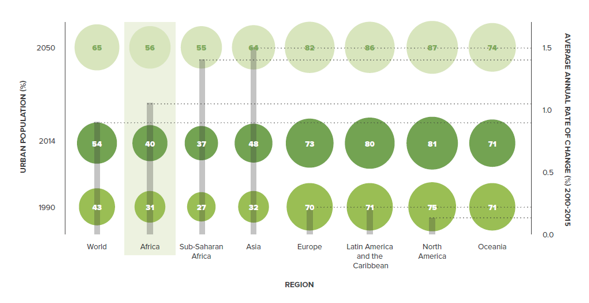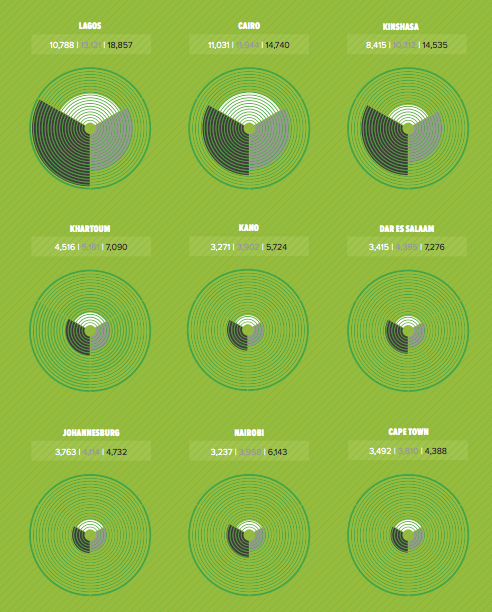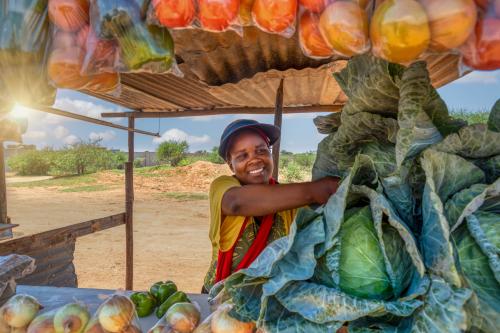The launch of Foresight Africa: Top priorities for the continent in 2016 is on the horizon. In anticipation of this year’s report, the Africa Growth Initiative team offers the below preview of one of the major topics covered and encourages you to check out the report here. You can also join the conversation on Twitter using #ForesightAfrica.
Historically, urbanization was a sign of economic prosperity. As a country underwent structural transformation, and its economy shifted from agriculture to manufacturing and industry, the composition of the population of the country shifted from being predominantly rural to predominantly urban. However, urbanization in the African context displays different characteristics from the ones witnessed in Asia and Latin America. Rather, African cities are seeing fast growth, engendering the emergence of megacities, without the structural transformation urbanization has been compiled with in the Asian and Latin American context.
Fast urbanization, slow structural transformation
As chapter three of this year’s Foresight Africa shows, with an average annual rate of 1.4 percent between 2010-2015, Africa is the second-fastest urbanizing continent, second only to Asia (Figure 1). Despite the substantial urban growth experienced in the last decade, however, Africa is and will remain the least urbanized region: By 2050, Africa’s urban population will only represent 55 percent of the country’s total population, compared to 64 percent and 86 percent in Asia and Latin America, respectively. While fast and uncontrolled urbanization presents several challenges—such as housing informality, poor sanitation, crime—a low urban population can impede economic prosperity. As our viewpoint authors, Brookings Metropolitan Policy research associate, Joseph Parilla, and senior fellow and deputy director, Alan Berube, note, “There are no wealthy countries that are not urbanized, but there are plenty of urbanized countries that are not wealthy.” In other words, urbanization is a necessary, but not sufficient, condition for economic prosperity. African countries must now strive to capitalize on urbanization and strive to become high-income urbanized nations.
The growth of the African megacity and the importance of financing urban infrastructure
Shown below are nine of the 10 biggest cities in Africa (Abidjan not shown). Right now, three of them—Lagos, Cairo, and Kinshasa can be considered “megacities,” in that they have 10 million people or more. Within the next few decades, many other sub-Saharan and North African cities—for example, Johannesburg, Nairobi, Dar-es-Salaam, Khartoum, Casablanca, and others—will reach that 10 million person threshold. Unsurprisingly, then, the total number of individuals living in Africa’s urban areas is expected to rise from 400 million in 2010 to 1.26 billion in 2050. This growth demonstrates a great need for better urban management and institution building, especially because over 60 percent of African urban residents live in slums. Thus, if managed properly, the megacity can engender several economic opportunities as cities offer economies of scale, which can be conducive to sustainable economic prosperity and improved human development.
Note: Estimations shown in thousands of people and show population estimations/projections for 2010, 2015, and 2025, respectively. For example, in 2010, Lagos had 10,788,000 residents.
Still, “urban management and planning” should not be confined to megacities, says Jérôme Chenal, senior scientist at the Urban and Regional Planning Community at Ecole Polytechnique de Lausanne, in his Foresight issue brief. Chenal stresses the importance of managing intermediate cities, i.e., cities where population lies below 10 million people, as urban growth in said cities is most pronounced.
In that light, viewpoint author and mayor of the city of Dakar, Senegal, Khalifa Sall, stresses the importance of municipal finance for urban development for his citizens and all African cities. In fact, the city of Dakar—population lies between 3 million and 5 million people—is presently working towards establishing the region’s first municipal bond in order to fund urban infrastructure projects.
For more in-depth analysis on urbanization in the African context as well as the importance of planning, infrastructure, and finance for Africa’s growing cities, make sure you check out Foresight Africa: Top priorities for the continent in 2016 and join the conversation on Twitter using #ForesightAfrica.
The Brookings Institution is committed to quality, independence, and impact.
We are supported by a diverse array of funders. In line with our values and policies, each Brookings publication represents the sole views of its author(s).





Commentary
Foresight Africa 2016: Urbanization in the African context
December 30, 2015